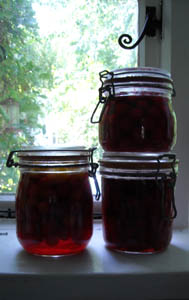Still laid up but I’ve been bottling foraged fruit
Posted by Fiona Nevile in Cottage tales, Hedgerow food, Preserving | 42 comments
Photo: Bottled cherry plums
I’m getting to the end of my third week being in bed. Finally last week my doctor discovered that I have a problem with my kidneys. I was beginning to wonder whether I’d just fade away like one of Dicken’s heroines.
So now we are waiting for more test results. Meanwhile I languish in the big spare room bed feeling lousy. I get up for a couple of hours in the afternoon. I’ve been out on two mini foraging trips to harvest wild plums and have bottled (canned) six kilos to eat in the winter months. I’ve also been harvesting the chubby wild blackberries that grow in our garden for wine and bottling with sliced apples. Gentle satisfying exercise.
We usually make jam, jelly and chutney with the wild cherry plums but this year I wanted to try bottling this fruit. When I was a child my mum bottled a lot of fruit (freezers were rare in those days) and I loved looking at the jars lined up on the larder shelves. Comfortable, squat, their fruit suspended in the coloured syrup.
There’s lots of good advice about bottling on the internet. I found the allotment.org.uk site very useful. In the end I rang my mum and she looked up her old method in her ancient Ideal Gas cookery book. Here are the instructions for bottling plums.
- Make a syrup of anything between 4ozs (113g) to a pound (454g) of white sugar to one pint (568ml) of water. My mum tipped to use the minimum sugar as too much can make the syrup taste sickly.
- Sterilise jars, rings and caps. Always use new rubber seals.
- Wash fruit and discard any bad or bruised fruit.
- Set the oven to Gas Mark ½ (120°C, 250°F).
- Pack the jars very tightly with the plumbs pushing them firmly down.
- Put several sheets of newspaper into a deep baking tray (to absorb any liquid that bubbles over)
- Place the jars two inches apart on the baking tray. Fill to the makers mark (about an inch below the rim) with boiling syrup. Lids on very loosely (not tightened or clipped shut).
- Bake in the centre of the oven for 45 minutes. (Times change depending on the fruit used).
- Remove the baking tray and seal the topsof the jars firmly using a thick oven cloth.
- Leave for 24 hours before testing the seals.
Leave a reply





Hi Paul
Yes I’ve noticed a lot of rowan berries too. I’m going to try Tess’s suggestion. HFW has written a good jelly recipe here
http://www.guardian.co.uk/lifeandstyle/2006/oct/21/recipes.foodanddrink
Hi Tess
Thanks for that recipe suggestion.
You don’t need a jelly bag. You can use an old piece of cotton (I’ve used an ancient pillowcase in the past) and a sieve. Sterilise the cotton by ironing it.
My parents have made rowan jelly to eat with lamb for as long as I can remember. There is a recipe in Jane Grigson, I think, and certainly one in Mrs Beeton. They mix it with apples — either crab or cooking — and use a jelly bag to strain them. I am just about to make some myself (though the rowans are a bit too ripe now but I went to John Lewis two weeks’ ago to buy a jelly bag and they were out of stock — and the Lakeland set is SO expensive — so I was stopped in my tracks). The jelly is especially delicious with meat (instead of redcurrant) and with brie and camembert, but I suppose you could eat it on toast too.
Out and about recently I couldnt help but notice a fairly abundant crop of rowanberries. Does anyone use these in any way. I thought they would be an ingredient for hedgerow jam. Any other ideas?
Hi Steelkitten
I spotted a discussion on www.moneysavingexpert.com about using normal jars for bottling. I didn’t include it here as I’m not sure how safe they are to use.
If I was to use this method, I’d losely screw the lids on and then tighten them when they came out of the oven using a thick oven cloth.
Have you ever used normal big jars with the vacuum pop lids? I’ve got loads of these and thought about bottling my greengages in them, but was never sure of how to do the lids. Do I leave them loose but unscrewed until they come out of the oven and then screw them on firmly?
Thanks -I will give it a go but if anyone else can come up with something I will try it!I am off to keep an eye on my elderberry source as I intend to make lots more gin-hic!
Hello Paul
I think that you’re a bit early for sloes.
Haven’t found any wild hazel nuts yet but HFW has some good ideas and recipes here http://www.guardian.co.uk/lifeandstyle/2007/sep/08/features.recipes
Hope you get better soon. Havent been on this site since last year but as I feel the urge to get out into the hedgerows again I thought it would be wise to give you a visit again. So far I have been unable to track down any sloes this year as I want so much to make sloe gin. Maybe I am a bit early(I live in Co. Fermanagh) but what I have found is loads of wild hazelnuts! The question is what to do with them? Ideas please before they disappear!!!
Hi Tree
Just put the whole washed plums into the jars. Pack them in as firmly as you can.
I know this is a really silly question – but do you stone the plums first or anything – or do you just put whole washed plums into the jars?